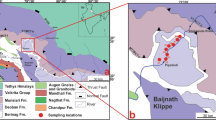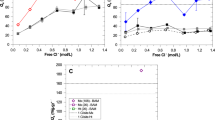Abstract
The alkali-silica reaction (ASR) is a chemical deterioration of concrete that involves reactive forms of silica. Volcanic glass is one of the potentially reactive forms of silica that can be present in volcanic rocks such as basalts. The aggregates used for concrete purposes from the Azores and Hawaiian Archipelagos are mainly of basic composition (basalts s.l.). In general, there is no report of ASR damaged structures in both archipelagos. However, in order to evaluate the behavior of these rocks regarding ASR and to compare the rocks from the two archipelagos, a set of methodologies were performed on a total of twenty-one volcanic aggregates. Geochemical analysis, total alkali-silica diagram, CIPW norm calculation, and petrographic analysis are some of the methods used for the assessment and analysis of rocks. The study was also complemented by electron probe microanalysis (EPMA) in order to identify the composition of volcanic glass and by X-ray diffractometry (XRD) for the Hawaiian aggregates. The results obtained from the studied aggregates showed that there are some differences between the two archipelagos. The rocks from the Azores are alkaline while the majority of the rocks from Hawaiian Archipelago are tholeiitic. The petrographic study revealed that the analyzed rocks from the Hawaiian Islands contain a higher quantity of interstitial volcanic glass than those from the Azores Archipelago. The EPMA carried out in some samples from the Hawaii showed that the volcanic glass has a composition of silica higher than 65%, value that is considered in the literature as potentially reactive.





Similar content being viewed by others
References
Abdel-Monem AA, Fernandez LA, Boone GA (1975) K-Ar ages from the Eastern Azores group (Santa Maria, São Miguel and Formigas islands). Lithos 8:247–254
ASTM C1260 (2014) Standard test method for potential alkali reactivity of aggregates (mortar-bar method), annual book of ASTM standards. American Society for Testing and Materials, Pennsylvania
ASTM C1293 (2015) Standard test method for determination of length change of concrete due to alkali-silica reaction, annual book of ASTM standards. American Society for Testing and Materials, Pennsylvania
Bérubé MA, Duchesne J (1996) Alkali contribution by aggregates to concrete.In: 10th International Conference on Alkali-Aggregate Reaction in Concrete, Melbourne, Australia, 1996, pp. 899–906
Bérubé MA, Fournier B (2004) Alkalis releasable by aggregates in concrete-significance and test methods. In: 12th International Conference on Alkali-Aggregate Reaction in Concrete. Beijing, China, 2004, pp. 17–30
Cannat M, Briais A, Deplus C, Escartín J, Georgen J, Lin J, Mercouriev S, Meyzen C, Muller M, Pouliquen G, Rabain A, Silva P (1999) Mid-Atlantic Ridge-Azores hotspot interactions: along-axis migration of a hotspot-derived event of enhanced magmatism 10 to 4 Ma ago. Earth Planet Sci Lett 173:257–269
Clague DA, Dalrymple GB (1987) The Hawaiian–Emperor volcanic chain, Part I, geologic evolution: U.S. Geological Survey Professional Paper 1350, v. 1, p. 5–54
Çopuroğlu, O., Andiç-çakir, Ö., Broekmans, M.A.T.M., and Kühnel, R.A., (2009). Mineralogy, geochemistry and expansion testing of an alkali-reactive basalt from western Anatolia. Mater Charact (60/7), special issue (35): 756–766
Cross W, Iddings JP, Pirsson LV, Washington HS (1902) A quantitative chemico-mineralogical classification and nomenclature of igneous rocks. J Geol 10:555–690
CSA A23.2-14A (2014) Potential expansivity of aggregates; procedure for length change due to alkali-aggregate reaction in concrete prisms. Canadian Standards Association, Mississauga, Ontario
CSA A23.2-25A (2014) Test method for detection of alkali-silica reactive aggregate by accelerated expansion of mortar bars. Canadian Standards Association, Mississauga, Ontario
Drolet C, Duchesne J, Fournier B (2017) Effect of alkali release by aggregates on alkali-silica reaction. Constr Build Mater 2017(157):263–276
Fernandes I, Broekmans MATM (2013) Alkali-silica reactions: an overview. Part I. Metallogr Microstruct Anal 2:257–267
Fernandes I, Medeiros S, Costa IR, Nunes JC, Quinta-Ferreira M (2015) Petrographic and chemical characterization of concrete deterioration products. In: Proceedings of the 15th International Multidisciplinary Scientific GeoConference SGEM GeoConference on Science and Technologies in Geology, Exploration and Mining, volume 2, pp. 511–518
Fernandes I, Ribeiro MA, Broekmans MATM, Sims I (Eds) (2016) Petrographic atlas: characterization of aggregates regarding potential reactivity to alkalis. RILEM TC 219-ACS Recommended Guidance AAR-1.2, for use with the RILEM AAR-1.1 Petrographic Examination Method Springer, 193 pp. DOI: https://doi.org/10.1007/978-94-017-7383-6
Fournier B, Bérubé MA (1993) Recent applications of a modified gel pat test to determine the potential alkali-silica reactivity of carbonate aggregates. Cem Concr Compos 15:49–73
Giaccio G, Zerbino R, Ponce JM, Batic OR (2008) Mechanical behavior of concretes damaged by alkali-silica reaction. Cem Concr Res 38(7):993–1004. https://doi.org/10.1016/j.cemconres.2008.02.009
Gill R (2010) Igneous rocks and processes: a practical guide. 1st edn. Wiley-Blackwell, 438pp.
Guðmundsson G, Ólafsson H (1999) Alkali-silica reactions and silica fume, 20 years of experience in Iceland. Cem Concr Res 29:1289–1297
Katayama T (2010) Diagnosis of alkali-aggregate reaction – polarizing microscopy and SEMEDS analysis. Proceedings of the 6th International Conference on Concrete under Severe Conditions (CONSEC’10), Merida, Mexico (1), 19–34
Katayama T, St John DA, Futagawa T (1989) The petrographic comparison of rocks from Japan and New Zealand-potential reactivity related to interstitial glass and silica minerals. In: Okada, K, Nishibayashi, S and Kawamura, M (eds) Proceedings of the 8th International Conference on Alkali-Aggregate Reaction in Concrete (ICAAR). Kyoto, Japan: 537–542
Katayama T, Helgason TS, Olafsson H (1996) Petrography and alkali-reactivity of some volcanic aggregates from Iceland. In: Shayan, A (ed) Proceedings of the 10th International Conference on Alkali-Aggregate Reaction in Concrete, Melbourne, Australia: 377–384
Korkanç M, Tuğrul A (2004) Evaluation of selected basalts from Nigde, Turkey, as source of concrete aggregate. Eng Geol 75(3–4):291–307
Korkanç M, Tuğrul A (2005) Evaluation of selected basalts from the point of alkali-silica reactivity. Cem Concr Res 35:505–512
Larrea P, França Z, Widom E, Lago M (2018) Petrology of the Azores Islands. In: Kueppers U, Beier C (eds) Volcanoes of the Azores: revealing the geological secrets of the Central Northern Atlantic Islands. Springer, Heidelberg, pp 197–249
Le Bas MJ, Le Maitre RW, Streckeisen A, Zanettin B (1986) A chemical classification of volcanic rocks based on the total alkali-silica diagram. J Petrol 27:745–750
Le Maitre RW (1976) Some problems of the projection of chemical data into mineralogical classifications. Contrib Mineral Petrol 56:181–189
Le Maitre RW, Streckeisen A, Zanettin B, Le Bas MJ, Bonin B, Bateman P, Bellieni G, Dudek A, Efremova S, Keller J, Lameyre J, Sabine PA, Schmid R, Sørensen H Wooley AR (2005) Igneous rocks: a classification and glossary of terms. Recommendations of the International Union of Geological Sciences Subcommission on the Systematics of Igneous Rocks. Cambridge University Press, 2nd Edition. 256 pp
Le Roux A, Ouali A, Guédon-Dubied, JS (1997). Alcali-réaction- Importance de la connaissance pétrographique dans la démarche préventive. Bulletin des Laboratoires des Ponts et Chaussées, Paris, France, 1997. No. 211, pp. 133–139
Lourenço J N (2007) Tectono-magmatic processes at the Azores Triple Junction. PhD thesis on Sciences of the Sea, speciality in Marine Geology. University of Algarve, Faro, Portugal. 267p
Mackenzie WS, Donaldson CH, Guilford C (1982) Atlas of igneous rocks and their textures. Longman Group UK Ltd, Harlow, Essex, 148 pp
Marfil S, Batic O, Maiza P, Grecco L, Falcone D (2010) Comportamiento de rocas basálticas de las Prov. de Corrientes y Entre Ríos frente a la reacción álcali-sílice (RAS). VI Congreso Uruguayo de Geología. Parque Vte. Minas, Lavalleja, Uruguay, Paper Nº 37, 6 pp. Publicado en CD.
Marfil S, Locati F, Maiza P, Lescano L (2013) Basaltic rocks from Argentina used in concrete structures. Global View of Engineering Geology and the Environment, Chapter 38, 253–258. In: International Symposium and 9th Asian Regional Conference of IAEG, Wu & Qi (eds).© 2013 Taylor & Francis Group, London
Medeiros S, Katayama T, Zanon V, Fernandes I, Silva AS, Nunes JC, Miranda V, Soares D (2012) Assessment of the potential alkali-reactivity of volcanic aggregates from Azores Islands. In: Drimalas T, Ideker JH, Fournier B (Eds) Proceedings of the 12th International Conference on Alkali-Aggregate Reaction in Concrete, Austin, Texas, USA, 10 pp
Medeiros S, Fernandes I, Nunes JC, Fournier B, Santos Silva A, Soares D, Ramos V (2016) The study of the azorean volcanic aggregates from the point of view of alkali silica reaction. In: Bernardes HM, Hasparyk NP (Eds) Proceedings of the 15th International Conference on Alkali-Aggregate Reaction in Concrete, São Paulo, Brazil, 10 pp
Needham HD, Francheteau J (1974) Some characteristics of the rift valley in the Atlantic Ocean near 36°48′North. Earth Planet Sci Lett 22:29–43
RILEM AAR-1.1 (2016) Detection of potential alkali-reactivity–part 1: Petrographic examination method. In: Nixon, PJ, Sims, I (eds) RILEM recommendations for the prevention of damage by alkali-aggregate reactions in new concrete structures. RILEM State-of-the-art Report (17): 35–60
RILEM Recommended Test Method AAR-0 (2016) Outline guide to the use of RILEM methods in the assessment of the alkali-reactivity potential of aggregates. In: Nixon, P.J. and Sims, I. (eds) RILEM recommendations for the Prevention of Damage by Alkali-Aggregate Reactions in New Concrete Structures, RILEM State-of-the-Art Reports 17, Springer: 5–34. doi:https://doi.org/10.1007/978-94-017-7252-5_2
Rogers N, Hawkesworth C (1999) Composition of magmas. In: Sigurdsson H, Houghton B, Rymer H, Stix J, McNutt S (eds) Encyclopedia of volcanoes, 1st edn. Academic Press, San Diego, pp 115–131
Šachlová Š, Kuchařová A, Pertold Z, Přikryl R (2016) Evaluation of alkali-silica reaction potential of quartz rich rocks by alkaline etching of polished rock sections. Environ Earth Sci 75(9):1–14. https://doi.org/10.1007/s12665-016-5519-3
Šachlová Š, Kuchařová A, Pertold Z, Přikryl R, Fridrichová M (2017) Quantitative assessment of alkali silica reaction potential of quartz-rich aggregates: comparison of chemical test and accelerated mortar bar test improved by SEM-PIA. Bull Eng Geol Environ 76(1):133–144. https://doi.org/10.1007/s10064-015-0812-z
Schilling J-G (1975) Azores mantle blob rare earth evidence. Earth Planet Sci Lett 25:103–115
Sherrod DR, Sinton JM, Watkins SE, Brunt KM (2007) Geologic map of the state of Hawai‘i. U.S. Geological Survey Open-File Report, Reston, pp 2007–1089
Soares, D., Santos Silva A., Mirão, J., Fernandes, I., Menéndez, E., (2016). Study on the factors affecting alkalis release from aggregates into ASR. In: 15th International Conference on Alkali-Aggregate Reaction in Concrete. São Paulo, Brazil, 2016, pp. 1–10
Wigum BJ, Björnsdóttir VD, Olafsson H, Iversen K (2007) Alkali aggregate reaction in Iceland–new test methods. VGK-Hönnun Consulting Engineers, Report No. VH 2007-036: 74 pp
Wigum BJ, Lindgård J, Sims I, Nixon PJ (2016) Rilem activities on alkali–silica reactions: from 1988–2019. Proc Inst Civil Eng: Construct Mater 169(4):233–236
Funding
The present work is a contribution to the PhD Project “Volcanic aggregates and alkali-silica-reactions in the world: a comparative study with Azores aiming to enhance concrete durability on volcanic oceanic islands” (refª: M3.1.a / F / 006/2015), with the support of the Regional Science Fund and Technology of the Regional Government of the Azores (Fundo Regional para a Ciência e Tecnologia) and co-financed by the European Social Fund through the Operational Program AÇORES2020 FEDER FSE. EPMA was performed at Université Laval in Canada, funded by NSERC Discovery Grant RGPIN-2018-04532. SEM/EDS analyses were performed at CEMUP, with equipment funded by projects REEQ/1062/CTM/2005 and REDE/1512/RME/2005 of Portuguese Foundation for Science and Technology (FCT). The thin sections from Hawaiian Islands were produced in the Faculty of Sciences of the University of Lisbon. Publication supported by project FCT UIDB/50019/2020 – Instituto Dom Luiz.
Author information
Authors and Affiliations
Corresponding author
Rights and permissions
About this article
Cite this article
Medeiros, S., Fernandes, I., Fournier, B. et al. Hawaiian and Azorean volcanic aggregates: a preliminary study of the potential alkali-silica reaction. Bull Eng Geol Environ 80, 8949–8960 (2021). https://doi.org/10.1007/s10064-019-01702-z
Received:
Accepted:
Published:
Issue Date:
DOI: https://doi.org/10.1007/s10064-019-01702-z




